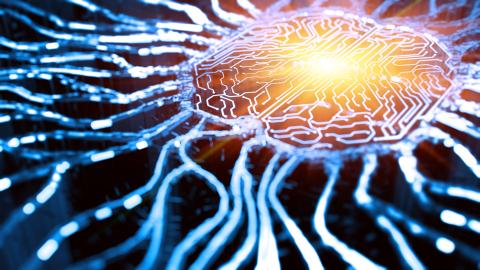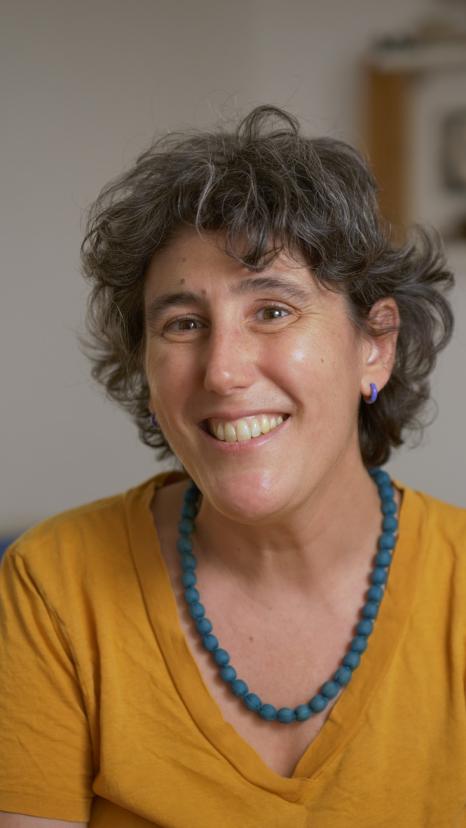
Julie Grollier: using spins for neural networks
Julie Grollier is a physicist and CNRS director of research at the Albert Fert Laboratory (LAF - Univ. Paris-Saclay/National Centre for Scientific Research, CNRS/Thales). A specialist in spintronics and artificial intelligence, her research focuses on the development of neuromorphic chips that physically reproduce a neural network. A 2018 CNRS silver medallist, she was also named the 2021 Irène Joliot-Curie Woman Scientist of the Year for her work.
Julie Grollier's scientific vocation was shaped by two key moments. The first came during her childhood reading, particularly Mrs. Frisby and the Rats of NIMH, the story of exceptionally intelligent laboratory rats who use science to help one another. The second, and more decisive, moment was an experimental internship she undertook while studying at an engineering school, at the Laboratory of Crystallography and Materials Science (CRISMAT) in Caen. "I loved the atmosphere in this lab. While my school friends were dreaming only of finance, at CRISMAT I met a community of curious, enthusiastic and passionate people. Through my interactions with them, I immediately knew that I wanted to pursue a career in research," recalls Julie Grollier. Fearing that she would not succeed, she first obtained a teaching qualification (agrégation) in applied physics. With this achievement under her belt, she finally decided to embark on a career in research.
Spin control
After completing a DEA (equivalent to a 2nd year Master's degree today) in condensed matter, she began a thesis in spintronics on magnetisation reversal under the supervision of Albert Fert, winner of the Nobel Prize in Physics in 2007. "We demonstrated that magnetisation can be controlled by an electric current. Initially, we were just interested in memory-type applications, but we gradually realised that we could create magnetisation dynamics," explains the researcher. She then decided to extend her research by carrying out two post-doctorates on the magnetisation dynamics of nanomagnets, the first at the University of Groningen, in the Netherlands, and the second at the Institute of Fundamental Electronics, in Orsay. In 2005, she was recruited as a CNRS research fellow at the CNRS-Thales joint physics unit, renamed in 2023 the Albert Fert Laboratory (LAF - Univ. Paris-Saclay/CNRS/Thales).
The discovery of neuromorphic electronics
While working in this laboratory and exploring the fundamental effects of spintronics, particularly the interactions between conduction electrons and magnetic materials, once again, reading would change the course of Julie Grollier's research. "In a science outreach article in 2008, I was fascinated to learn that researchers in the United States had been able to mimic synapses using components and nanotechnologies. For several days, it was all I could think about, and I regretted that I wasn't conducting this kind of research myself. Then, as I thought about it, I wondered if I couldn't do the same thing - imitate neurons - with spintronics." A new chapter of research opened up for Julie Grollier.
Creating the first artificial neuron using spintronics
From that moment on, driven by this promising scientific intuition, Julie Grollier spared no effort. "I began by training myself, studying all the articles by American researchers on the subject, organising seminars and eventually filing a patent," explains the researcher. These first steps enabled her to create an interdisciplinary research group based on this theme, secure a European Research Council (ERC) grant and obtain some spectacular initial results in just a few years. "In 2017, my team and I published a paper in Nature, in which we demonstrated a first nano-neuron which, due to the properties of spintronics, is capable of mimicking neural networks to perform small tasks, such as recognising spoken numbers from zero to nine," explains the researcher.
Towards the energy-efficient neural network
Having taken this first step, Julie Grollier and her team were determined to go further. They began exploring how to build real neural networks that function more like the human brain. Once again, the first results soon followed. "We successfully demonstrated a small neural network, with a dozen or so spintronic components, which can perform exactly the same operations as an algorithmic neural network. And we're already developing much larger networks of spintronic nano-neurons and nano-synapses, communicating via microwaves, interconnected and with densities approaching that of the brain," adds the researcher, who has already filed three patents in this area. As part of the European RadioSpin research programme, this new research orientation, aimed at building a hardware neural network, opens up unprecedented prospects, insofar as a neuromorphic processor would reduce the power consumption of artificial intelligence by a factor of 100 or even 1,000. So, it is hardly surprising that companies such as Thales and Bosch are interested in Julie Grollier's work, in the hope of creating microchips capable of learning for tasks such as medical diagnosis.
The power of working together, at the intersection of disciplines
Although Julie Grollier's current research is part of a European programme, she admits that she prefers to work in a small team. "The human aspect is really very important to me: I love interacting with the students I support, discussing ideas with my colleagues on a daily basis and sharing my failures and successes. I believe that it's through these exchanges and the active listening that fuels my imagination that I find my main driving force," she explains.
She enjoys fostering these exchanges at the intersection of disciplines, as evidenced by the interdisciplinary research group she established in 2015. "To make progress on my research theme, I had to learn to talk to people in materials, electronics, computing and neuroscience. After ten years of exciting dialogue, I think it's fair to say that we've succeeded in building a wonderful community!" she adds.
Changing the image of the scientist
However, in her beloved world of research, she cannot help noticing that women are still far too few and far between. "I believe there's an urgent need to communicate and change the stereotypical image of scientists, who are still too often perceived as cold, grey-haired men in white coats. I like to remind people that science - often mistakenly called 'hard' - is anything but cold. On the contrary, it conveys enormous emotion and women have every right to be a part of it," concludes the woman who was named Woman Scientist of the Year in 2021.

